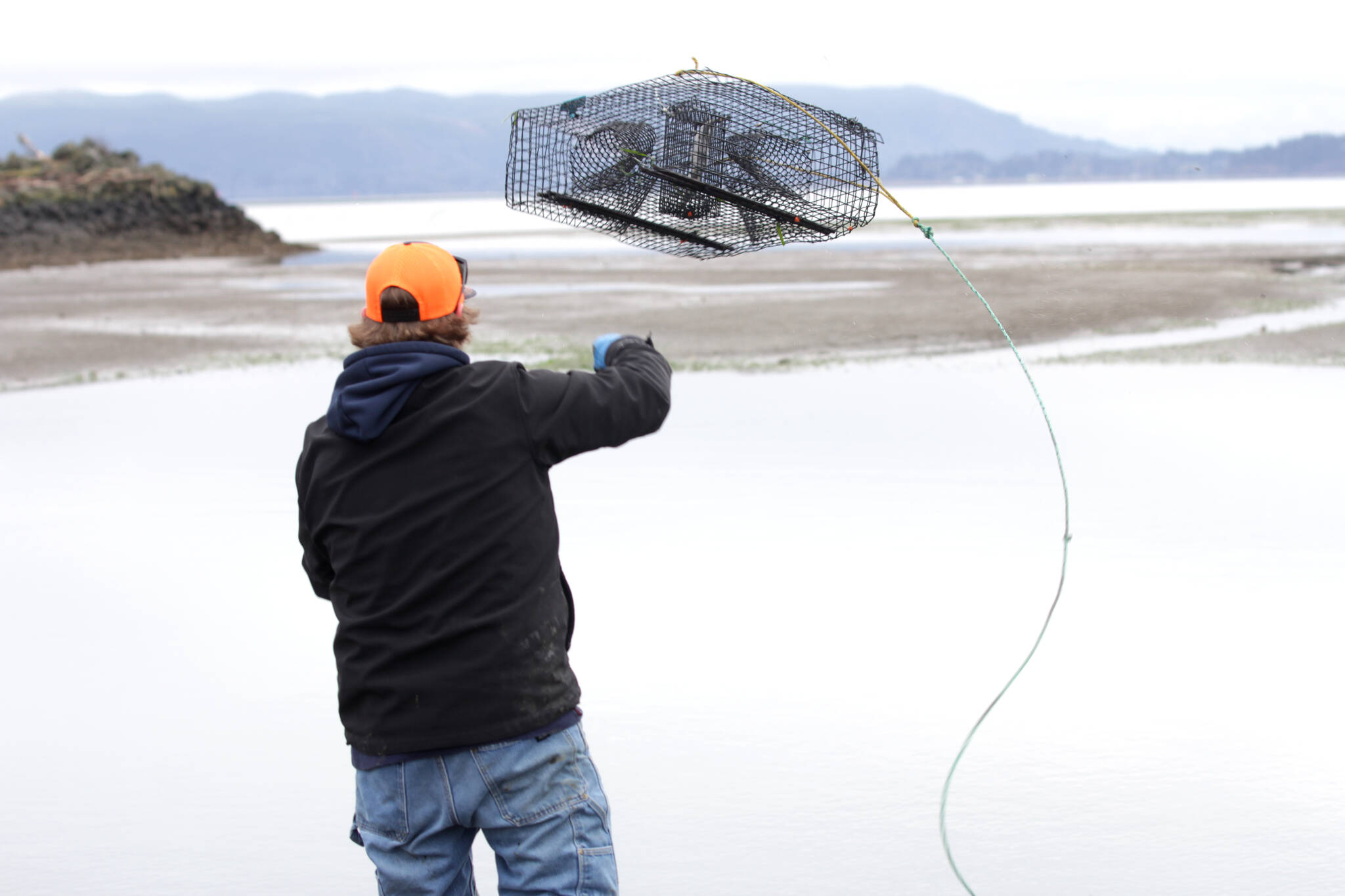It’s a mild January morning, overcast but not raining, as I step around a bird carcass and watch the tribal employees struggle through the all-consuming mud laid bare by the low tide as it seeks to claim their rubber boots.
One by one, they drag crab pots up the breakwater, shaking them empty and counting the crabs present by type before noting the numbers down on a clipboard and pouring the European green crab into buckets for removal, while the Dungeness crab who got inadvertently trapped alongside their European cousins are granted a last-second reprieve and chucked back into the mud.
You can hear the green crab moving around in the buckets, a low sort of clicking, as they get dragged down the breakwater to the next crab location.
All this is in service of the Shoalwater Bay Indian Tribe’s efforts to account for and remove the invasive green crab from their lands near Tokeland.
“It’s an invasive species,” said Larissa Pfleeger-Ritzman, director of natural resources for the tribe. “This is just another problem for everyone to face. We don’t even know the total population.”
Green crab are native to Europe, but stateside, are considered an invasive species. Likely transported to the U.S. in the ballast tanks of ships, the crab population has exploded in the last several decades.
According to the National Oceanic and Atmospheric Administration, green crab are considered one of the most invasive species in the marine environment; it has few predators, eats juvenile king crab and salmon, and outcompetes Dungeness crab for resources. Green crab have been spotted as far north as Metlakatla, threatening already imperiled crab harvests in Alaska.
Discerning the size of the problem
The scope of the issue is one of the biggest problems, Pfleeger-Ritzman said: how many crab are down there? The tribe began its trapping and removal efforts in 2020, hitting its stride with consistent cycles in 2022 after declared a tribal emergency for the green crab in 2021, Pfleeger-Ritzman said.
“One day, we thought it would be a short day, and we ended up having like, 600 crab at one site and 500 at another,” Pfleeger-Ritzman said. “We have to trap and monitor our traps every day. We can’t leave them in the water. That’s how we’re functioning now, trapping as we can. We’re limited by tides and such.”
The tribe, funded by an invasive species grant from the Bureau of Indian Affairs, traps and removes thousands of crab each month, said Richard Ashley, a member of the tribe’s Department of Natural Resources. Their efforts are concentrated on the peninsula containing Tokeland.
“We focus on all of Tokeland,” Ashley said in an interview. “If we focus on these areas, we’re going to get the crab out of them.”
The green crab, which are smaller and have minimal meat compared to most crab species, are destroyed and used for things like fertilizing gardens, Pfleeger-Ritzman said. The Shoalwater Bay Tribe has the highest number of crab captured for the amount of traps put out of any agency reporting to the Washington Department of Fish and Wildlife, Pfleeger-Ritzman said.
“We’re taking care of the tribal ground,” Pfleeger-Ritzman said. “That’s our responsibility.”
Next steps
Identifying the numbers of green crab present in the region, as well as a better understanding of the impact they’re having on the ecosystem around them, is key to dealing with the issue, Pfleeger-Ritzman said. The department is also set to take delivery of an airboat to expand the range that they’re able to lay traps around the area, expanding the data they’re able to gather.
“More funding for people that are doing the trapping would be good,” Pfleeger-Ritzman said. “Once we get an airboat, we’ll go look and do an assessment.”
Both the size of the population and the damage they’re doing still need to be reckoned with, Pfleeger-Ritzman said.
“No one knows what the population is. We can’t even tell if we’ve scratched the surface,” Pfleeger-Ritzman said. “We don’t even know if we’ve done a dent. Relatively, we don’t know how long a population this large has been impacting the bay.”
But for now, that work will still involve tramping through the mud, pushing back one crab trap at a time.
Contact reporter Michael S. Lockett at 757-621-1197 or mlockett@thedailyworld.com.


